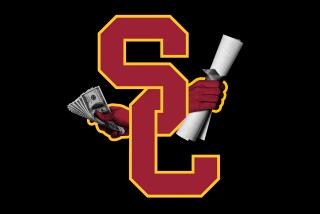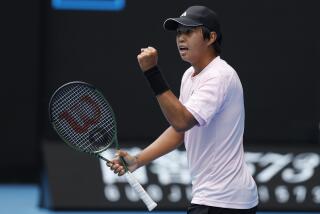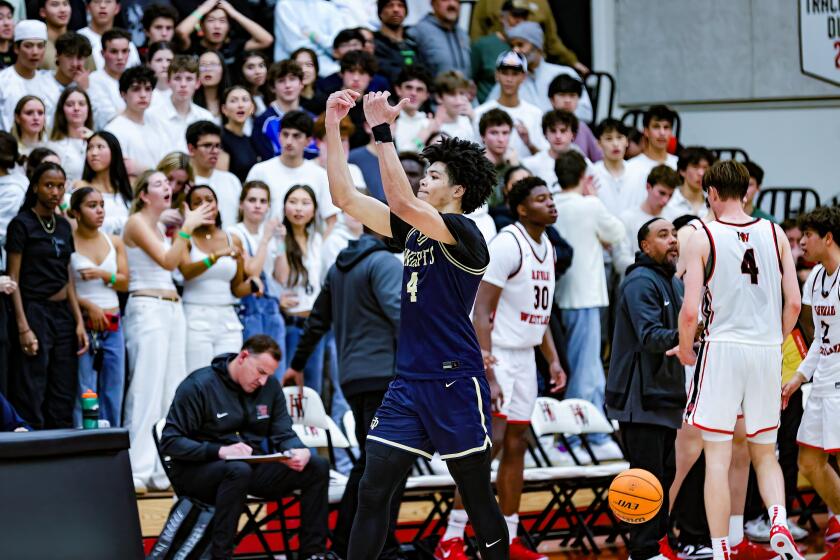Riding the Pipeline Into a Tennis Career
- Share via
Jonas Wallgard saw the opening and went for the payoff without hesitation.
He had been mulling over the notion for some time and had even put out feelers. But he wasn’t sure what to expect.
So when the beckoning letter arrived from the tennis coach at a school called Pierce College an entire continent away from his Swedish hometown, Wallgard seized the opportunity.
Soon after, the promising player who already had played as an amateur on the European professional tour was in Woodland Hills, becoming the latest in a chain of foreign athletes to play for the Brahmas and Coach Paul Xanthos.
That was nine years ago and Wallgard is still reaping the benefits from that move.
Wallgard, now an assistant men’s tennis coach at Drake, exemplifies the reasons foreign athletes compete at U.S. junior colleges. And, like others, he parlayed the experience into a scholarship to a prestigious four-year university.
“I definitely benefited from the system,” said Wallgard, 29. “I was hoping to do what I did and everything went as planned.”
The first step for Wallgard, who was born and raised in Hollviken, a town of about 10,000, was to send a videotape of himself playing tennis to family friends in Westlake Village. The friends showed the tape to a local coach who suggested that Wallgard try a junior college. They recommended Pierce because of its outstanding tennis reputation.
The tape made its way to Xanthos, who then contacted Wallgard in a move that might have constituted a recruiting violation. Under California’s first-contact rule for junior colleges, an athlete outside a school’s designated recruiting area must initiate contact with a coach rather than the other way around.
Receiving a tape from a third party does not qualify as a first contact by an athlete, according to Walt Rilliet, state commissioner of community college athletics. Therefore, Xanthos’ letter to Wallgard would have been a first-contact violation. Rilliet said his office was not aware of any recruiting improprieties by Xanthos.
After he sent the tape, Wallgard said, he received a letter from Xanthos inviting him to join the Brahmas. Wallgard said he had never heard of Pierce or Xanthos.
“He wrote me a letter and said he was very impressed (with the tape) and that he had a spot for me on the team,” Wallgard said.
Wallgard then talked to Xanthos by telephone from Sweden and made arrangements to enroll at Pierce for the 1984-85 school year. He played for one season and won the state singles championship. Wallgard then accepted a scholarship to USC, where he played the next three seasons. He graduated with a degree in communications.
Wallgard said he paid about $3,000 in out-of-state tuition the year he attended Pierce and lived with family friends in Westlake Village. The money, he said, came primarily from his father, an advertising executive in Sweden.
At USC, Wallgard played primarily at No. 5 singles and had a 68-36 career record in singles. He became an undergraduate assistant to Coach Dick Leach during the 1989 season and took the post at Drake in June of that year when former Trojan assistant Roger Knapp, a good friend, was named the coach.
The controversy over foreign athletes at junior college schools also grips major universities. Wallgard sympathizes with the plight of marginal U.S. players trying to land a spot on a Division I roster and believes that a rule limiting the number of foreign players on each college team might be appropriate.
“This season we only have one guy in the top six who is American,” he said of Drake. “A lot of coaches are trying to get a rule to set limitations, maybe a school can have only two foreign players on the team.”
The Drake men’s tennis team includes three Swedes, one Norwegian and one Canadian. Wallgard echoed the sentiments expressed by many junior college coaches who claim that they must attract foreign players to keep their programs competitive, especially at less-prominent tennis programs such as the one at Drake.
“I can understand the (people in the) United States thinking that the foreign players are taking scholarships away from their players,” he said. “Maybe that’s bad. Today, there are very competitive schools all over the country and the reason they are competitive is that they bring in foreign players.
“We get so many letters from foreign players. The foreign players are really interested in coming.”
Nobody knows that better than Wallgard.
More to Read
Get our high school sports newsletter
Prep Rally is devoted to the SoCal high school sports experience, bringing you scores, stories and a behind-the-scenes look at what makes prep sports so popular.
You may occasionally receive promotional content from the Los Angeles Times.






